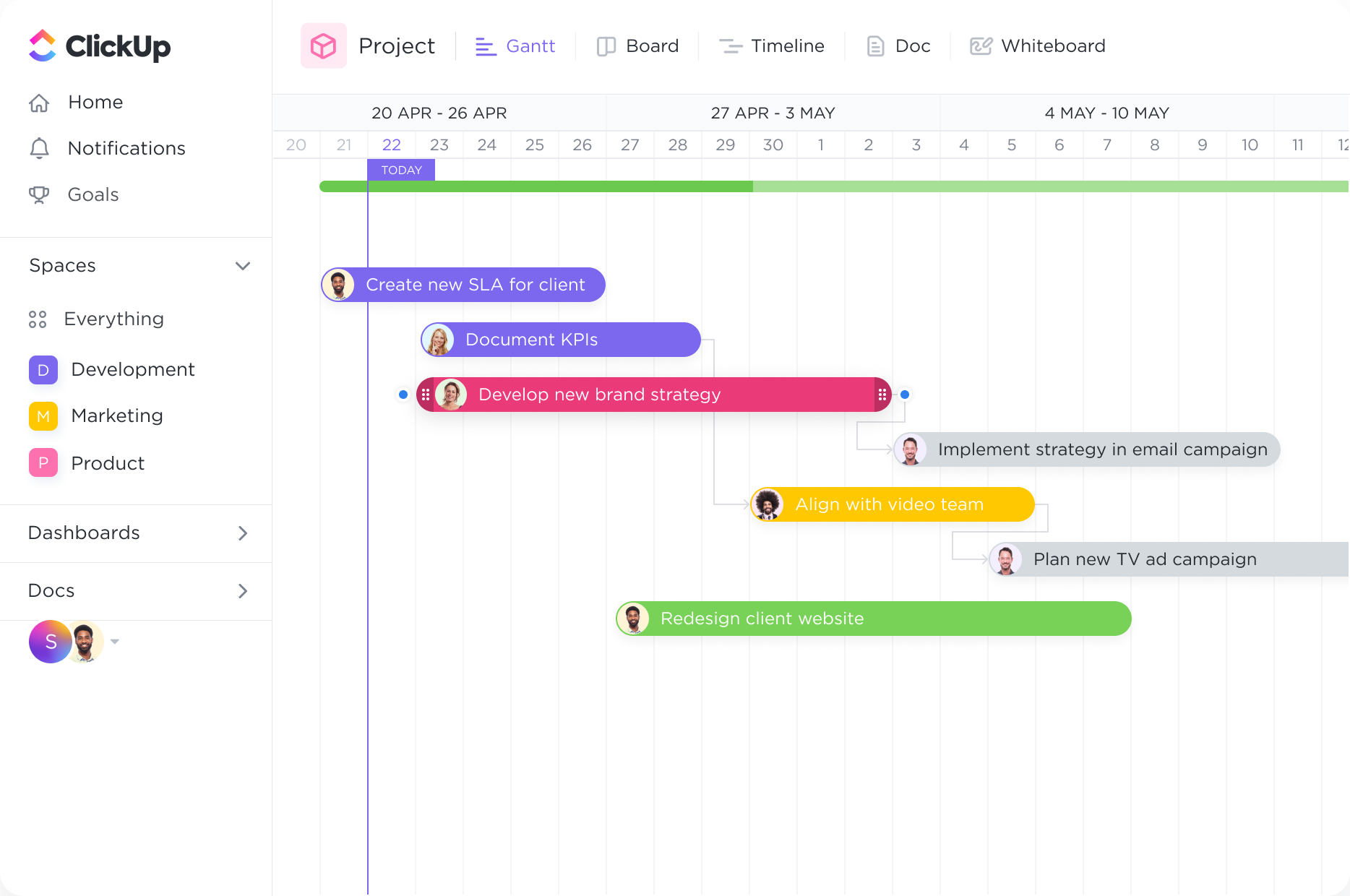Tracking
Eliminate bottlenecks before they happen.
Intelligent dependency-path tracking shows you where potential bottlenecks might exist to prevent inefficiencies.
Gantt Charts
Streamline your project management process with ClickUp's powerful Gantt Chart software. Visualize timelines, track progress, and allocate resources efficiently using this user-friendly tool. Simplify collaboration and stay on top of deadlines with ClickUp's intuitive interface, designed specifically for Project Managers. Upgrade your project management game today with ClickUp's Gantt Chart software.
Free forever. No credit card.

Tracking
Intelligent dependency-path tracking shows you where potential bottlenecks might exist to prevent inefficiencies.
Dependencies
Create tasks and link them with dependencies. Dragging a task with dependencies will automatically reschedule tasks in the chain
Gantt charts are invaluable tools for project managers to plan and schedule projects effectively. By visualizing the project timeline, deadlines, and milestones, project managers can create a clear roadmap for the entire team. This allows for better coordination, resource allocation, and task prioritization, resulting in improved project outcomes.
Project managers can use Gantt charts to allocate tasks among team members and track progress collectively. By assigning specific tasks and responsibilities to individuals, project managers can ensure that everyone knows their role and can work collaboratively towards project goals. Gantt charts also provide transparency, allowing team members to see how their tasks fit into the overall project timeline.
Managing and optimizing resources is crucial for project managers. Gantt charts enable project managers to allocate resources such as personnel and equipment efficiently. By visualizing resource availability and utilization, project managers can avoid bottlenecks, prevent overloading team members, and ensure that resources are used optimally throughout the project lifecycle.
Gantt charts provide project managers with a visual representation of project progress. By tracking completed tasks, milestones, and deadlines, project managers can monitor the project's overall progress and identify any potential delays or issues. This allows for timely intervention and adjustments to keep the project on track and ensure successful completion.
Gantt charts serve as powerful communication tools for project managers to share project status and updates with stakeholders. By presenting a visual representation of the project timeline and progress, project managers can effectively communicate project milestones, deadlines, and any changes or delays. This enhances transparency, fosters stakeholder engagement, and helps build trust and confidence in the project's management.
A Gantt chart can visually represent the project schedule, helping project managers keep track of important milestones and deadlines.
By displaying tasks and their dependencies, a Gantt chart can assist project managers in efficiently assigning resources to different tasks and ensuring that they are utilized optimally.
With a Gantt chart, project managers can easily identify the critical path of a project, which is the sequence of tasks that must be completed on time for the project to finish as scheduled. This helps in identifying potential bottlenecks and areas where additional resources may be needed.
A Gantt chart allows project managers to visualize the dependencies and interdependencies between tasks, ensuring that tasks are scheduled in the correct order and that any changes or delays are easily identified and managed.
Project managers can use a Gantt chart to track the progress of each task and milestone, allowing them to assess whether the project is on track and make any necessary adjustments or interventions.
A Gantt chart provides a clear visual representation of the project timeline and progress, making it easy for project managers to communicate updates, delays, and changes to stakeholders in a concise and understandable manner.
Most Gantt chart software provides user-friendly interfaces that allow you to easily create Gantt charts for your project. Simply input your project tasks, their durations, and dependencies, and the software will generate a visual representation of your project timeline. You can also customize the chart by adding milestones, assigning resources, and setting deadlines.
Yes, you can track the progress of multiple projects simultaneously with Gantt chart software. It provides a centralized platform where you can view the timelines, tasks, and milestones of each project, allowing for easy monitoring and comparison. This helps you identify any delays or bottlenecks across projects and make informed decisions to keep all projects on track.
Yes, Gantt chart software allows for collaboration and task assignment by providing a centralized platform where team members can view and update project timelines, assign tasks, and set dependencies. This streamlines communication, enhances coordination, and improves overall project efficiency.